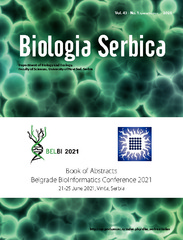Приказ основних података о документу
De Novo Transcriptome Sequencing of Ramonda serbica: Identification of Late Embryogenesis Abundant Proteins
| dc.creator | Pantelić, Ana | |
| dc.creator | Stevanović, Strahinja | |
| dc.creator | Kilibarda, Nataša | |
| dc.creator | Vidović, Marija | |
| dc.date.accessioned | 2021-08-18T08:10:18Z | |
| dc.date.available | 2021-08-18T08:10:18Z | |
| dc.date.issued | 2021 | |
| dc.identifier.issn | 2334-6590 | |
| dc.identifier.uri | https://cherry.chem.bg.ac.rs/handle/123456789/4503 | |
| dc.identifier.uri | http://ojs.pmf.uns.ac.rs/index.php/dbe_serbica/index | |
| dc.description.abstract | An extreme loss of cellular water or desiccation (5-10% of relative water content) leads to protein denaturation, aggregation and degradation, and affects the fluidity of membrane lipids resulting in loss of membrane integrity [1]. The essential constituents of vegetative desiccation tolerance in so-called resurrection plants are late embryogenesis abundant proteins (LEAPs). This heterogeneous group of anhydrobiosis-related intrinsically disordered proteins forms mostly random conformation when fully hydrated, turning into compact α-helices during desiccation [2]. Based on in vitro studies, LEAPs can be involved in water binding, ion sequestration, stabilization of both membrane and enzymes during freezing or drying, while by forming intracellular proteinaceous condensates they increase structural integrity and intracellular viscosity of cells during desiccation. Here, we identify 164 members of LEA gene family in endemic and relict resurrection species Ramonda serbica by integrating previously done de novo transcriptome and homologues protein motifs. Identified LEAPs were classification into six groups according to Protein family (PFAM) database and the most populated group was LEA4 containing 47% of total identified LEAPs. By using four secondary structure predictors, we showed that this group exhibited a high propensity to form amphipathic α-helices (81% of total sequence length is predicted to form α-helical structure). This implies that charged residues might be exposed to the solvent, while hydrophobic amino acids might interact with lipid bilayers or with other target proteins in the cell. In addition, as predicted by several bioinformatic tools, more than 70% of identified LEAPs were found to be highly disordered (~64%). Structural characterization of LEAPs is a key to understand their function and regulation of their intrinsic structural disorder-to-order transition during desiccation. These findings will promote transformative advancements in various fields, such as the development of new strategies in neurodegenerative disorders, cell preservation technology and the improvement of crop drought tolerance. | sr |
| dc.language.iso | en | sr |
| dc.publisher | Novi Sad : Faculty of Sciences, Department of Biology and Ecology | sr |
| dc.relation | info:eu-repo/grantAgreement/ScienceFundRS/Promis/6039663/RS// | sr |
| dc.relation | info:eu-repo/grantAgreement/MESTD/inst-2020/200042/RS// | sr |
| dc.rights | openAccess | sr |
| dc.rights.uri | https://creativecommons.org/licenses/by/4.0/ | |
| dc.source | Biologia Serbica | sr |
| dc.subject | desiccation tolerance | sr |
| dc.subject | intrinsically disordered proteins | sr |
| dc.subject | liquid-liquid phase separation | sr |
| dc.subject | resurrection plants | sr |
| dc.subject | secondary structure prediction | sr |
| dc.subject | water stress | sr |
| dc.title | De Novo Transcriptome Sequencing of Ramonda serbica: Identification of Late Embryogenesis Abundant Proteins | sr |
| dc.type | conferenceObject | sr |
| dc.rights.license | BY | sr |
| dcterms.abstract | Видовић, Марија; Стевановић, Страхиња; Пантелић, Aна; Килибарда, Наташа; | |
| dc.citation.volume | 43 | |
| dc.citation.issue | 1 (spec. ed.) | |
| dc.citation.spage | 65 | |
| dc.citation.epage | 65 | |
| dc.description.other | Book of Abstracts; Belgrade BioInformatics Conference 2021, 21-25 June 2021, Vinča, Serbia | sr |
| dc.type.version | publishedVersion | sr |
| dc.identifier.fulltext | https://cherry.chem.bg.ac.rs/bitstream/id/27338/De_Novo_Transcriptome_pub_2021.pdf | |
| dc.identifier.rcub | https://hdl.handle.net/21.15107/rcub_cherry_4503 |


